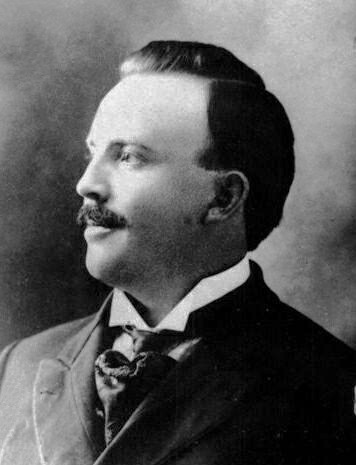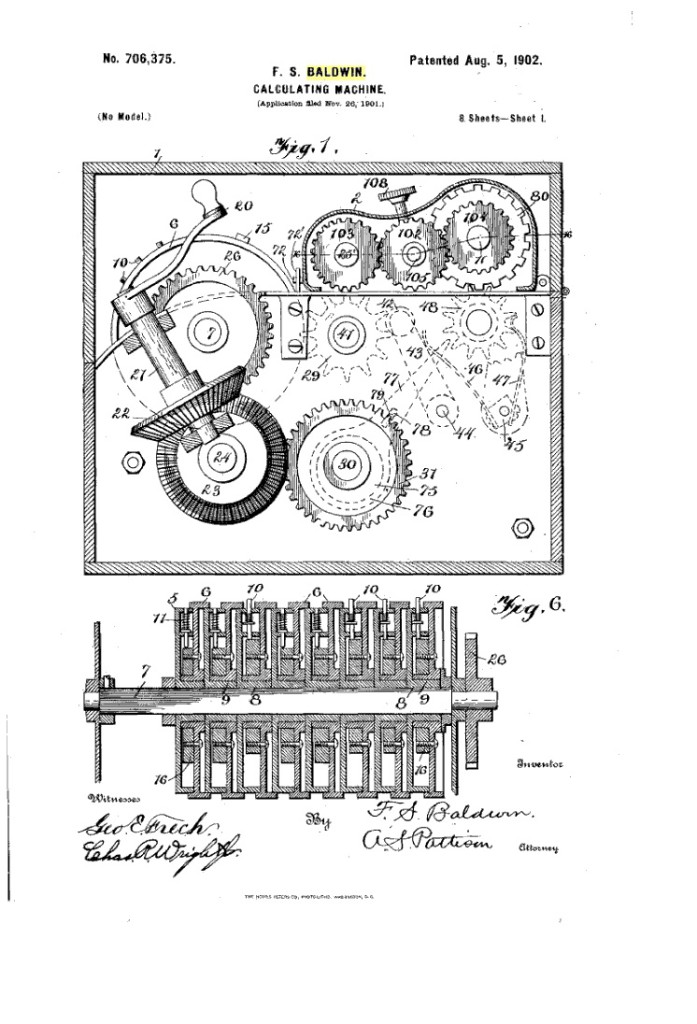
Frank Stephen Baldwin (1838-1925)
On April 10, 1838, American inventor Frank Stephen Baldwin was born, who invented a pinwheel calculator in 1874. He started the design of a new machine in 1905 and was able to finalize its design with the help of Jay R. Monroe who eventually bought the exclusive rights to the machine and started the Monroe Calculating Machine Company to manufacture it.
Frank Stephen Baldwin, Engineer
Baldwin was born in New Hartford, Connecticut. His father Stephen Baldwin was a master builder and owned an architectural business and in 1840 the family moved to Nunda, New York where Baldwin attended the Nunda Institute for elementary school. In 1854 he was enrolled at Union College in Schenectady, New York, to study engineering, but left when his father had an accident that left him as an invalid for the rest of his life. Frank then took over the management of his father’s architectural business. Baldwin’s life as an inventor began soon after he left Union College and in 1855, he applied for a patent on an “arrowhead self-coupler” for railroad cars. Unfortunately, the patent was rejected, but Baldwin became even more determined now to follow a life as an inventor.
Becoming an Inventor
His first successful application for a patent was in 1860 after he had moved with his family to Fort Wayne, Indiana, where his uncle had designed a corn-planter and Frank assisted in applying for the patent. In 1861 and during the American Civil War Baldwin enlisted in the Carlyle Home Guard, but only served for three months. In 1869, he went to St. Louis, Missouri as manager of Peck’s Planning Mills. In 1872 Baldwin married to Mary K. Denniston of Williamsport, Pennsylvania, and they had 6 children. Around this time he became more enthusiastic with ideas for inventions and he invented a metal latch to fasten shoes, an anemometer to record wind direction, a step for a street-car to record the number of passengers carried, and an indicator for a street-car to show the street name operated from the axle of the car. Soon after this he had an idea to build a calculating machine, the invention for which he is most famous.[1]
From the Recording Lumber Measure to Calculating Machines
His “Recording Lumber Measure” was a machine which automatically measured and recorded four different kinds of lumber at the same time. This device started him thinking about calculating machines and this point really marks the birth of the Monroe calculator. In the office of a life insurance company at St. Louis, he had seen an arithmometer, a calculating machine devised by Charles Xavier Thomas around 1820 and which, at the time, was the only mechanical desktop calculator in commercial production. To create a model based on his ideas he hired William Seward Burroughs I to perform the work in his machine shop in St. Louis.

Patent for Baldwin’s Calculator from 1902
Baldwin’s Machine
Baldwin’s machine had a single cylinder and sets of nine pins which could be retracted or extended. A handle was positioned at one of the digits 1 to 9 and this in turn extended the required number of pins. These extended pins engaged cogs on an intermediate pinion, so the number of extended pins determined the rotation of the pinion. The machine also contained a wedge which was used to “carry one” if this was required.[1] Baldwin’s calculator was very successful. But, he did not entirely concentrate on calculating machines for he was granted a U.S. Patent for a Cement Mixer in 1891, and for a Roundabout in 1892. However, he returned to further inventions relating to the calculator and he was awarded a U.S. Patent for the Baldwin Computing Engine on 9 January 1900. This machine performed multiplication or division with one stroke for each digit.
Success
He sold his calculator to various insurance companies in New York, and to various government departments in Washington. While showing his calculator to these government departments he was taken to the National Observatory and there introduced to Simon Newcomb, who highly complimented Baldwin on his invention. Baldwin returned to further inventions relating to the calculator and was awarded a U.S. Patent for the Baldwin Calculator on 5 August 1902, which was capable of doing a 12-digit multiplication in about 20 seconds with eight turns of the handle.[3]
Improving the Calculator Machine
Baldwin designed a listing machine in 1905 with only ten keys and a spacer. In 1908, he combined the advantages of the listing machine with the calculator for a new patent. In 1911, Baldwin became acquainted with Jay R. Monroe, who was associated with the Western Electric Company of New York. After a demonstration of Baldwin’s machine, Monroe immediately realized its possibilities and the two joined hands for its redesign to adapt Baldwin’s calculator to modern business, so that it was suitable for commercial production.[3] Monroe purchased the rights to the computer from Baldwin and began selling the calculator under the name Model G. The Monroe Calculating Machine Company, founded by Jay R. Monroe, manufactured the calculator. Frank Stephen Baldwin remained research director of the Monroe Calculating Machine Company until his death in 1925.[1]
George Dyson: The birth of the computer, [8]
References and Further Reading:
- [1] O’Connor, John J.; Robertson, Edmund F., “Frank Stephen Baldwin“, MacTutor History of Mathematics archive, University of St Andrews./li>
- [2] Caryn Hannan: Conneticut Biographical Dictionary, State HIstory Publications, 2008, pp. 58-59.
- [3] Frank Baldwin in History of Computers and Computing
- [4] Wilhelm Schickard and his Calculator Machine, SciHi Blog
- [5] Herman Hollerith and the Mechanical Tabulator, SciHi Blog
- [6] Charles Babbage – The Father of the Computer who hated Street Music, SciHi Blog
- [7] Frank Stephen Baldwin at Wikidata
- [8] George Dyson: The birth of the computer, TED @ youtube
- [9] Frank Stephen Baldwin. “Frank Stephen Baldwin Autobiography”
- [10] Timeline of Mechanical Calculators, via DBpedia and Wikidata






Pingback: Whewell’s Gazette: Year 3, Vol. #35 | Whewell's Ghost